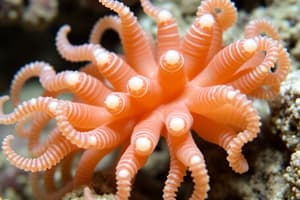Podcast
Questions and Answers
Hydra is a marine animal
Hydra is a marine animal
False (B)
Hydra feeds on small crustaceans and insect larvae
Hydra feeds on small crustaceans and insect larvae
True (A)
Hydra reproduces only asexually
Hydra reproduces only asexually
False (B)
The body of Hydra is elongated and has a basal disc for attachment
The body of Hydra is elongated and has a basal disc for attachment
Hydra has a respiratory and circulatory system
Hydra has a respiratory and circulatory system
Hydra belongs to the phylum Platyhelminthes
Hydra belongs to the phylum Platyhelminthes
The main unit of excretory system in Hydra is flame cell
The main unit of excretory system in Hydra is flame cell
Most Platyhelminthes are parasitic animals
Most Platyhelminthes are parasitic animals
Platyhelminthes have a simple digestive system with no anus
Platyhelminthes have a simple digestive system with no anus
Platyhelminthes are exclusively hermaphroditic except for Schistosoma
Platyhelminthes are exclusively hermaphroditic except for Schistosoma
Phylum Cnidaria (coelenterata) includes about 9000 species.
Phylum Cnidaria (coelenterata) includes about 9000 species.
Cnidarians are the simplest of eumetazoans.
Cnidarians are the simplest of eumetazoans.
The body of cnidarians consists of three layers.
The body of cnidarians consists of three layers.
Cnidarians reproduce only sexually.
Cnidarians reproduce only sexually.
Cnidarians have bilateral symmetry.
Cnidarians have bilateral symmetry.
Hydrozoa is a class of Cnidarians found only in marine habitats.
Hydrozoa is a class of Cnidarians found only in marine habitats.
Medusoid form is one of the stages in the life cycle of Cnidarians.
Medusoid form is one of the stages in the life cycle of Cnidarians.
Cnidarians have a calcareous skeleton.
Cnidarians have a calcareous skeleton.
Cnidarians have a cavity in the body called coelenteron.
Cnidarians have a cavity in the body called coelenteron.
Sea anemones belong to the class Anthozoa.
Sea anemones belong to the class Anthozoa.
What is the habitat of Hydra?
What is the habitat of Hydra?
Where are the testes found in Hydra?
Where are the testes found in Hydra?
How does Hydra reproduce during normal conditions?
How does Hydra reproduce during normal conditions?
What is the main unit of the excretory system in Hydra?
What is the main unit of the excretory system in Hydra?
How does Hydra obtain its food?
How does Hydra obtain its food?
What type of symmetry do Platyhelminthes exhibit?
What type of symmetry do Platyhelminthes exhibit?
What is the main unit of the excretory system in most Platyhelminthes?
What is the main unit of the excretory system in most Platyhelminthes?
How do most Platyhelminthes obtain nutrients?
How do most Platyhelminthes obtain nutrients?
Which class does Hydra belong to within the phylum Cnidaria?
Which class does Hydra belong to within the phylum Cnidaria?
What is the structure at the distal end of Hydra that has a mouth on hypostome?
What is the structure at the distal end of Hydra that has a mouth on hypostome?
What is the main characteristic of the body of cnidarians?
What is the main characteristic of the body of cnidarians?
How do cnidarians reproduce?
How do cnidarians reproduce?
What type of symmetry do most cnidarians exhibit?
What type of symmetry do most cnidarians exhibit?
Where are the testes found in Hydra?
Where are the testes found in Hydra?
What is the habitat of most cnidarians?
What is the habitat of most cnidarians?
What is the main unit of the excretory system in most cnidarians?
What is the main unit of the excretory system in most cnidarians?
Which class of cnidarians includes Hydra and Obelia?
Which class of cnidarians includes Hydra and Obelia?
What are nematoblasts used for in cnidarians?
What are nematoblasts used for in cnidarians?
What is the function of coelenteron in the body of cnidarians?
What is the function of coelenteron in the body of cnidarians?
What is the main form of reproduction seen in cnidarians?
What is the main form of reproduction seen in cnidarians?
Flashcards are hidden until you start studying
Study Notes
Characteristics of Hydra
- Hydra is a marine animal that feeds on small crustaceans and insect larvae.
- It has an elongated body with a basal disc for attachment.
- Hydra has a respiratory and circulatory system.
Reproduction and Excretory System
- Hydra reproduces asexually.
- The main unit of the excretory system in Hydra is the flame cell.
Classification and Characteristics of Platyhelminthes
- Hydra belongs to the phylum Platyhelminthes.
- Most Platyhelminthes are parasitic animals.
- They have a simple digestive system with no anus.
- Platyhelminthes are exclusively hermaphroditic except for Schistosoma.
Characteristics of Cnidarians
- Phylum Cnidaria (coelenterata) includes about 9000 species.
- Cnidarians are the simplest of eumetazoans with a body consisting of three layers.
- They reproduce sexually and have bilateral symmetry.
- Hydrozoa is a class of Cnidarians found only in marine habitats.
- The medusoid form is one of the stages in the life cycle of Cnidarians.
- Cnidarians have a calcareous skeleton and a cavity in the body called coelenteron.
- Sea anemones belong to the class Anthozoa.
Studying That Suits You
Use AI to generate personalized quizzes and flashcards to suit your learning preferences.




